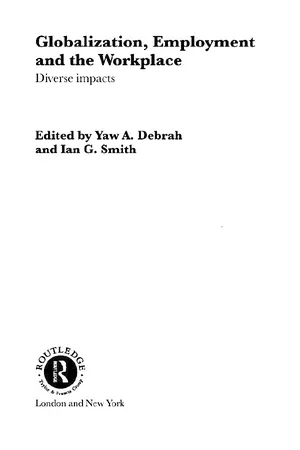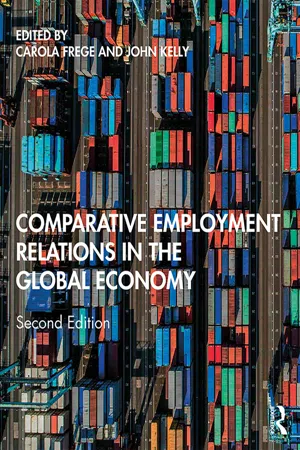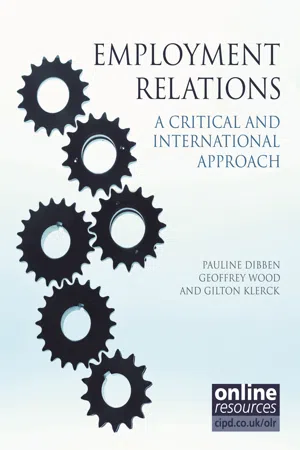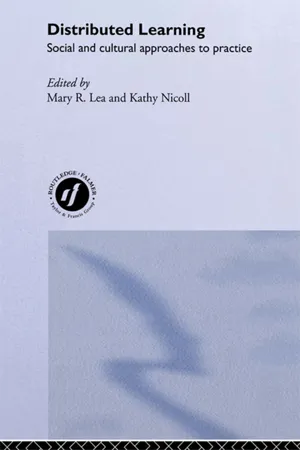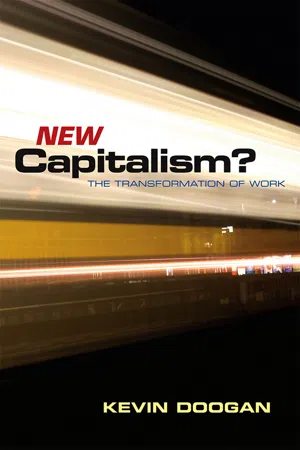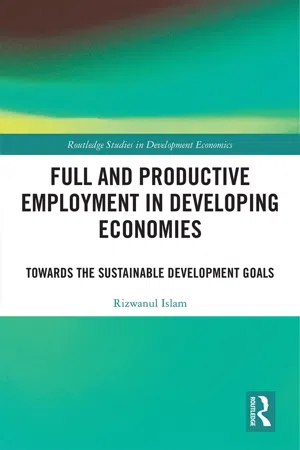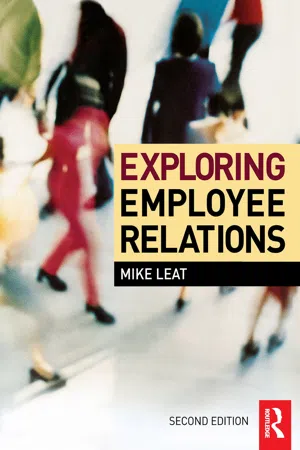Social Sciences
Globalisation and Employment
Globalization and employment refer to the impact of global economic integration on job opportunities and labor markets. It encompasses the outsourcing of jobs to other countries, the rise of multinational corporations, and the increasing interconnectedness of global labor markets. This phenomenon has both positive and negative effects on employment, influencing job creation, wages, and working conditions worldwide.
Written by Perlego with AI-assistance
Related key terms
9 Key excerpts on "Globalisation and Employment"
- eBook - ePub
- Louise Warwick-Booth(Author)
- 2022(Publication Date)
- SAGE Publications Ltd(Publisher)
Globalisation has been defined in a number of ways within the academic literature, which shows that it has many components, such as social, cultural and economic aspects (Jacobsen 2014). While globalisation is an imprecise term, it is ultimately a process driven by technological change and advancements in communications, with the pace of such changes being very fast compared to previous historical eras (Giddens and Sutton 2021), despite global social change being nothing new. In brief, globalisation can be described as the increased social, economic and political interconnectedness of the world.Defining globalisationGiddens and Sutton (2021: 112) describe globalisation as ‘characterised by a set of processes that bind the societies and people of the world into tighter interdependence and by a growing global consciousness that influences how people act’. Globalisation has many components, including:- processes associated with social change;
- the stretching or extension of activities, relations and networks globally;
- the intensification of human activities;
- the speeding up of human activities;
- differential impacts on different societies;
- the production of winners and losers in terms of social inequalities.
Source: www.globalsociology.pbworks.comGlobalisation is an ‘extremely complex phenomenon’ (Huynen et al. 2005; Giddens and Sutton 2021), involving interconnection, the interdependence of activities across boundaries, and the development of consciousness and identification of the world as a single place (Holton 2005). There are many areas of research in the social sciences literature exploring the impact of globalisation, as detailed in Table 10.1 .Table 10.1 Table headings adapted from Sklair (2002)These approaches are also subject to various criticisms; for example, that the notion of having a global consciousness is idealistic and that much of the evidence base related to globalisation is contradictory. The central argument made by many scholars of globalisation is that ‘many contemporary problems cannot be adequately studied at the level of the nation-states … but need to be seen in terms of transnational processes, beyond the level of particular countries’ (Sklair 2002: 27; Beeson 2016). Often such arguments focus on global forces and global power, suggesting that nation states are becoming less significant when compared to global actors, including transnational corporations. However, such corporations drive global capitalism, consumerism and social change from a western standpoint. The idea of an interconnected global society has raised several questions about the relationship between globalisation and inequalities, explored later in this chapter. Given that many social problems and issues are increasingly conceptualised as ‘global’, and therefore in need of global solutions, the role of global policy actors is important too. Thus, there are ongoing debates about the intersection of the global with the national in social policy terms, exploring power, politics and process (see Chapter 11 - eBook - ePub
- Yaw A. Debrah, Ian G. Smith(Authors)
- 2003(Publication Date)
- Routledge(Publisher)
In spite of the recent popularity of the concept of economic globalization in academic debates, there is a dearth of research on its implications on work, the workplace, employment and trade unions. This book attempts to provide empirical evidence to shed light on some of the views and debate in the literature on the impacts of economic globalization on the workplace and employment. It attempts to contribute to the debate by bringing together research from the UK, the USA, Africa, Latin America, Australia, Continental Europe and East Asia to illuminate our understanding of what is actually happening to organizations, workforces, employee groupings/representatives and individual employees as a result of economic globalization.In this regard, this chapter provides a broad overview of the concept of economic globalization, the factors that account for the move towards economic globalization, the issues pertaining to the impacts of economic globalization on employees particularly, on employment, incomes and labour relations. This chapter also provides the key themes of the book. In relation to this it reviews the important issues examined in the various chapters. These include:- the pressures facing both local and global firms in a globalized era and the various ways in which they are responding to the human resource management (HRM) challenges brought about by globalization;
- the impact of reverse diffusion on the nature of employment relations in the domestic workplaces of multinational corporations (MNCs);
- effects of economic liberalization on employment, wages, skills and other labour issues;
- the implications of globalization for industrial relations, trade union organizing and campaigns;
- an assessment of the debate on the impact of globalization on labour, work and employment in some specific industrial sectors.
Upon examination of issues presented in this book it is argued that the influence of globalization on work and employment, and on the labour process and the management process is inexorable and at the same time imperfectly understood. International business activity is at the same time complex in nature and pressurizing nation–states and cultures in novel ways, with little known as yet about medium to long-term outcomes. Hence, revealing the reality, the nature, extent and significance of economic globalization remains a learning process involving the expansion of a body of knowledge and understanding on the subject. In this regard, the following chapters represent substantial contributions to this learning process and better understanding from the perspective of the nation–state, and employee and business/ management. - Carola Frege, John Kelly, Carola Frege, John Kelly(Authors)
- 2020(Publication Date)
- Routledge(Publisher)
In what follows this chapter will not distinguish between economic and political migrants and it will use the broader OECD definition, thus we regard the new residency of migrants (or refugees) as core, not whether they are in paid employment. Migration is not just a geographical but also a social phenomenon. If one conceptualizes migration as a social process one can easily see that it affects multiple dimensions of migrants’ and natives’ social life. Research on migration is therefore intrinsically inter-disciplinary (Castles and Miller 2009: 21). It is discussed among labour and developmental economists (Borjas 2013b; Portes and Rumbaut 2014) as well as sociologists, psychologists, anthropologists, political scientists, geologists, legal scholars to name a few (for a detailed review of migration theories see Massey et al. 1993; Portes and DeWind 2004; Brettell and Hollifield 2007). Migration scholars have focused on five areas of interest: (i) who migrates, from where and why (geographic regions, economic and political circumstances, climate change, demographic variables, skills etc.); (ii) migration impact on sending countries (e.g. brain drain, remittances) as well as broader discussions of globalization and the global labour force in developing as well as advanced economies; (iii) the international and national regulations of migration (international and national laws and entry policies); (iv) migration’s economic and social impact on receiving countries: the economic and social/cultural integration of migrants, challenges and opportunities for receiving economies and societies; public attitudes towards migrants; and finally (v) the impact of migration and integration on migrants themselves: social networks, identities, career/life changes and chances, inter-generational progress in terms of social status and economic success; ethnic and racial discrimination et al.Employment relations touches on all five dimensions. Migration has been attributed to globalization and has been studied as central to the dynamics of exchange of commodities, capital and labour across national borders (McGovern 2007; Rodriguez and Grafton 2007: 60; Zientara 2011). For example, Rodriguez and Mearns (2012) described the present decade as an ‘era of mobilities’, which has significant implications for labour markets and employee relations across the world (also Halfacree 2012: 209). ‘These dynamics have influenced the way employment relations are structured and experienced in local and global workplaces, which hints to a multi-dimensional impact of globalization on employment relations’ (Rodriguez and Mearns 2012: 580). Of particular importance is migration’s impact on the increasing deregulation of global labour markets and the flexibilization of the workforce (Golash-Boza 2015). Work is being outsourced to transitional economies in the South while other developing economies rely on their unemployed workers to migrate to the North (and send remittances).- eBook - ePub
Employment Relations
A Critical and International Approach
- Pauline Dibben, Geoffrey Wood, Gilton Klerck(Authors)
- 2011(Publication Date)
- CIPD - Kogan Page(Publisher)
From a critical perspective, markets create inequalities and the globalisation of markets increases the scale and extent of inequality (Dicken 2007). Globalisation leads to a reduced role for government and has implications for safety nets, while corporate finance often requires labour market deregulation (Perkins and Shortland 2006). Indeed, Meiksins Wood (1997) argues that:There is one major reason why we need to be so careful about how we use the term ‘globalisation’. We have to guard against treating the trends that go under that name as if they were natural, inevitable processes, instead of historically specific capitalist processes, the capitalist exploitation of human beings and natural resources, aided and abetted by a direct collaboration between the state and capital.LEGISLATION IN PRACTICE
Regulation for equality
The above statement by Meiksins Wood (1997) implies that markets should be regulated.Assuming that this argument is accepted, how should this happen? Should nation states take the lead in regulating markets? Is it the responsibility of international institutions? Or is this the role of civil society, through anti-globalisation movements (see, for example, Worth and Kuhling 2004).HOW IS GLOBALISATION RELEVANT TO HUMAN RESOURCE STUDIES AND EMPLOYMENT RELATIONS?
Globalisation is relevant to human resource studies in a range of ways. Firstly, human resources are often seen as a main source of competitive advantage (Porter 1990, cited in Rubery and Grimshaw 2003). There are a range of approaches within the literature that explain how HR contributes towards company performance. One approach assigns value to human intellectual capital, and attempts are made to leverage this asset to produce higher-value products – essentially captured by the resource-based view. Another approach relates to the bundle of HR practices referred to as high-performance practices (eg involvement, training, teamwork and performance-related pay) (Brewster et al - eBook - ePub
Employment
A Key Idea for Business and Society
- Jamie Woodcock(Author)
- 2023(Publication Date)
- Routledge(Publisher)
Chapter 2 THE GLOBAL DIVISION OF LABOURDOI: 10.4324/9781003279907-3A chapter on the global division of labour is a significant undertaking. Rather than try to explain how the division of labour is expressed across each country and every sector, this chapter instead will provide a global overview on dynamics of employment as shaped by these broad divisions. One of the challenges of thinking about the global division of labour is one of statistics. Employment is constantly changing and shifting. By the time you could build an accurate picture of employment (even at a local level, let alone global) the realities would have changed underneath. However, the fact is that one country – and in this case due to where the author lives, Britain – becomes used as though it is an exemplar of employment, or indeed that employment everywhere else must be broadly similar.This chapter starts by tracing out employment across the world, examining higher level statistics. The next part introduces imperialism as a key driver of these changes, both historically and today. The chapter then moves on to discuss some key changes that are reshaping global employment, particularly discussing how work or workers can move. Unemployment is considered next, as well as the different kinds of informal work that many people are engaged in. Finally, the chapter considers alternatives to employment.Employment Across the World
Historically, collecting data on employment has relied on a variety of different measures, including surveys, self-reporting from employers, government agencies, other investigations, and often tax records. There are problems with all of these measures, often resulting in undercounting in key areas. However, there are broad outlines of employment that can be used to make some comparisons. In Table 2.1 - eBook - ePub
Distributed Learning
Social and Cultural Approaches to Practice
- Mary R. Lea, Kathy Nicoll(Authors)
- 2013(Publication Date)
- Routledge(Publisher)
Until relatively recently, ‘the world’ was largely discussed either as an aspect of international relations or what is termed ‘world systems theory’. The former focuses on the relations between nation states, the latter on capitalist economic relations. Each has been subject to the criticism that their particular foci marginalise and exclude large and important trends in the world, in particular the cultural dimensions and the impact of information and communication technologies. In response to these limitations, different conceptions of globalisation have emerged that have stimulated debate about its nature, extent and novelty as a phenomenon, particularly in relation to the economy (Hirst and Thompson 1996a, b), but also in relation to politics and culture (Waters 1995; Edwards and Usher 2000).At its simplest, the notion of globalisation may be expressed as ‘the compression of the world and the intensification of consciousness of the world as a whole’ (Robertson 1992: 8) or, as Waters (1995: 3) suggests, ‘a social process in which the constraints of geography on social and cultural arrangements recede and in which people become increasingly aware that they are receding’. It signifies the shrinking of the world where people, services and goods are connected to each other across the globe through a variety of means and in increasingly immediate ways. Airline tickets bought in England are processed in India. CNN and McDonald's are available on a global scale. People migrate for work, leisure and increasingly as refugees. The Internet, fax and telephone put people instantly in touch with each other, even though they may be in different hemispheres. Investment decisions taken in one country may well affect workers and investors in several other countries. What in the past would have taken months to move around the globe now takes days or even seconds. The economic, political and cultural dynamics of these processes are the focus of much debate and dispute.Popular discussion of globalisation treats it as an entirely new phenomenon arising from the conditions of the immediate present. However, globalisation has a history and geography of its own. In this context, the contemporary interest in globalisation is the result of an intensification of certain processes and the awareness of the globe as a single environment. Robertson (1992), for example, provides one outline of the historical phases of the long, uneven and complicated process of globalisation. First, he identifies the Germinal Phase that lasted in Europe from the early fifteenth to the late eighteenth century. Although this is associated with the growth of national communities, it also embraces the spread of ideas about humanity and, perhaps more importantly, the Gregorian calendar, a step towards a global conception of time. The Incipient Phase lasted until the 1870s, once again mainly grounded in Europe, and saw the consolidation of the nation state and the development of international relations. The Take-Off Phase lasted until the mid-1920s, in which there were increasing global assumptions about what a nation state should be and how it should act. There was the implementation of ‘world time’, a sharp increase in the amount and speed of global communication, and a growth in global competitions, such as the Olympic Games. The mid-1920s to the late 1960s saw the Struggle for Hegemony Phase, particularly between the Second World War and the cold war adversaries seeking to determine the direction of the globalising processes in line with their own ideologies. The Holocaust and atom bomb provided defining perspectives on the prospects for humanity within this period. The current phase since the late 1960s is what Robertson (1992) terms the Uncertainty Phase, in which global consciousness has become heightened, with international systems more fluid, the prospects for humanity more fraught in the light of environmental and other risks, and with the increase in global communications and the consolidation of the global media. Alongside and in response to trends towards global integration, white, ‘western’ male assumptions that underlie dominant conceptions of humanity and society have been called into question by considerations of gender, sexual, ethnic and racial differences, the increased multiculturalism of societies and notions of the hybridity of cultures. - eBook - ePub
- Kevin Doogan(Author)
- 2013(Publication Date)
- Polity(Publisher)
3 Globalization: Mobility, Transnationality and EmploymentIn progressing this materialist critique of new capitalism, this chapter moves on to discuss globalization. Globalization is a multidimensional concept but the principal approach adopted here relates to its perceived role in promoting relational change within capitalism. In Bauman’s Liquid Modernity globalization creates new forms of engagement between capital and labour based on tenuous connections between firms and workers and a much greater sense of individualization, whereas for Giddens globalization gives rise to a ‘post-traditional society’. Traditional roles within the family and the community are undermined by a greater awareness of, and engagement with, modern life styles, non-traditional work outside the home and new expressions of sexuality and intimacy. In his view the transformation of work is emphasized in the decline of traditional industries, traditional skills and crafts and the spread of nontraditional ‘a-typical’ forms of employment which give rise to new social relations in the home, at work and wider society.Parallels between narratives of globalization and the network society are evident in that both accounts, to varying degrees, stress the autonomy of social process. Moreover, just as Castells is keen to abstract informationalism from industrialism, Giddens similarly stresses that new dynamics express modern forms of globalization.The first phase of globalization was plainly governed by the expansion of the West, and institutions which originated in the West. No other civilization made anything like so pervasive an impact on the world, or shaped it so much in its own image. Yet, unlike other forms of cultural or military conquest, disembedding via abstract systems is intrinsically decentred, since it cuts through the organic connection with place upon which tradition depended - eBook - ePub
Full and Productive Employment in Developing Economies
Towards the Sustainable Development Goals
- Rizwanul Islam(Author)
- 2019(Publication Date)
- Routledge(Publisher)
7 Globalization of production and the world of work Is a race to the bottom inevitable? 1 Introduction Economic globalization involves trade, capital flows, and the movement of labour, and an important element in that process is the globalization of production. With the gradual dismantling of trade barriers, and capital flows becoming easier, globalization of production has flourished. It is no longer necessary to produce goods in one location. Even though a product may bear the mark of being produced in a particular country, its components may come from different locations. This is particularly the case with high-tech products for which research and development (R&D) is usually carried out in developed countries, components are made in different countries depending on their competencies, and the final assembly takes place in another country. This approach is also used for labour-intensive goods, such as garments, shoes, etc. Globalization of production has influenced the world of work in ways not seen before. 2 While some impacts have been positive from the point of view of workers, others have given rise to serious concerns. On the positive side, new employment opportunities hitherto unknown in many developing countries have opened. On the other hand, serious pressure on the working class has come through the stagnation of real wages 3 and adverse workplace conditions. The term “race to the bottom” has come into circulation in this context. But this does not have to be the only way forward since there are useful positive aspects from which workers could benefit alongside the rest of the global community - eBook - ePub
- Mike Leat(Author)
- 2009(Publication Date)
- Routledge(Publisher)
- international trade unionism and their perceptions of globalization;
- the role played by some of the supranational regulatory organizations in seeking to influence the employee relations policies and practices of MNCs and the arguments surrounding the issue of minimum labour standards.
Globalization and the internationalization of business
There are a number of different dimensions and components to the internationalization of business:- a significant expansion of international trade;
- the liberalization of trade across national borders through the removal of tariff barriers, the extension of free trade agreements, for example the European Union (EU), and North Atlantic Free Trade Agreement (NAFTA), and the proposed free trade area including China, Japan, South Korea and Association of Southeast Asian Nations (ASEAN);
- development of more global product markets and enhanced pressures of international competition;
- the cross-national integration of production within MNCs;
- an expansion in the number and influence of MNCs through joint ventures, cross-national acquisitions and mergers or foreign direct investment (FDI);
- an international division of labour.
This globalization or internationalization of business has been significantly enabled by the development and use of new technologies, particularly in the arena of information transfer and communications. Also the increase in the size and extent of free trade agreements incorporating the free movement of capital inevitably facilitates cross-border investment of all kinds.The term Globalization has become increasingly used to describe both this process of internationalization and its outcomes. There are numerous different definitions of this term and the range of these definitions is illustrated by those of Ohmae (1990) ; Walters (1995) and Needle (2000)
Index pages curate the most relevant extracts from our library of academic textbooks. They’ve been created using an in-house natural language model (NLM), each adding context and meaning to key research topics.

